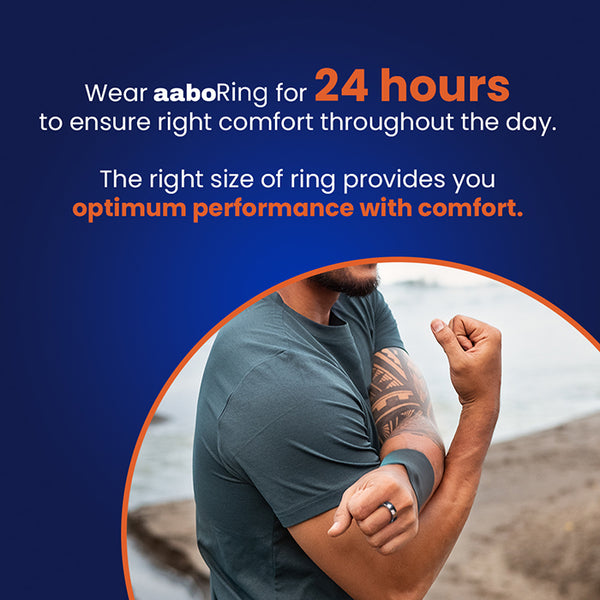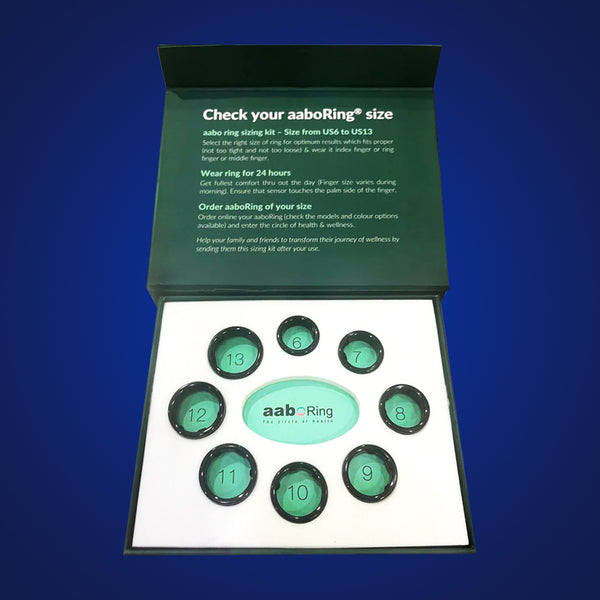
By Atul Hemani | Co-founder & CSO, aaboRing
A decade ago, the idea of wearing a computer on your wrist sounded like science fiction. Not long after, wearing your health on your wrist felt revolutionary. Today, wearable tech is not only real, it is routine. From runners and executives to caregivers and teens, people rely on wearables to track, understand, and improve their well-being.
The smartwatch has evolved from a fitness tracker into a lifestyle companion. But in the quiet corners of innovation, a new form factor is gaining ground: the smart ring. Small, sleek, and surprisingly powerful, it is emerging as a compelling alternative to the smartwatch, and perhaps, as the more intuitive companion for the connected future. Smart rings now prompt a critical question: Is less, more?
As someone who has spent years at the intersection of health tech, AI innovation, and consumer electronics, I have had a front-row seat to this transformation. I believe this is not a battle between devices; it is a shift in how we relate to technology itself. The question is no longer “What can my wearable do?” It is becoming, “How silently and smartly can it do it?” It is about asking what kind of intelligence we want in our lives, and how we want it to show up.
A Minimal Form with Maximum Impact
Smart rings strip away the noise. No screens. No flashing notifications. Just seamless, continuous tracking of the metrics that matter: heart rate, HRV, SpO₂, temperature variation, and sleep quality. But beyond the features, it is the philosophy of the smart ring that is resonating: unobtrusive technology that respects your attention. These devices are not shouting for engagement. They are built for effortless intelligence, and that, I believe, is a design principle more wearables will adopt in the years ahead.
Minimalism, in this context, is not a compromise; it is a signal. It reminds us that health monitoring does not need to be visible to be valuable, and users across the world are responding. From rising ‘smart ring India’ searches to accelerating adoption in the U.S., UK, Germany, Japan, Korea, and the Middle East, the appeal cuts across both age and gender.
Whether it is a working woman tracking her sleep cycle with a smart ring for women, a college student trying to manage erratic routines, or a senior executive seeking subtle insights into stress and recovery, users are moving towards devices that inform without interrupting. The design is not just about convenience; it is about alignment with real-life rhythm.
A young entrepreneur I recently spoke with said it best: “My ring doesn’t ask for attention. It just quietly supports me. That’s what I needed most.”
This sense of quiet support, of being consistently informed without being constantly notified, is at the heart of why more people are choosing to buy a smart ring online. Wearables that empower without overwhelming are no longer the exception; they are becoming the expectation.
Insights Without Intrusion: Data You Don’t Have to Look At
The true strength of smart rings lies in their ability to deliver rich, AI-powered health insights, without becoming yet another screen to manage. Unlike smartwatches, which are designed for interactivity and instant feedback, smart rings function as passive intelligence engines; continuously learning, adapting, and offering timely, contextual prompts.
It is not just what they measure: heart rate, HRV, sleep cycles, skin temperature, or blood oxygen saturation, but how silently they do it that makes them stand out. For individuals who feel overwhelmed by notifications or fatigued by screen time, a smart ring offers a more grounded and less intrusive way to engage with personal health.
I recall a conversation with a startup founder in her late 30s who had recently made the switch from a smartwatch to a ring. “I was getting anxious tracking my anxiety,” she laughed. Her smart ring, in contrast, did not demand her attention; it supported her well-being quietly, consistently. Even when it came to tracking her sleep, a crucial parameter in overall wellbeing, the idea behind having to remove your smartwatch to keep it for charging overnight, thus missing out on sleep insights, seemed absurd and counterproductive. That shift, from being managed by tech to feeling supported by it, is deeply powerful. This is especially relevant in today’s overstimulated world. For those seeking a ring for stress tracking, or a smart ring for health monitoring, the ability to collect and interpret personal data passively, and then convert it into simple, meaningful nudges, is a genuine differentiator.
This becomes critical for users who rely on smart rings for real health outcomes, not just using the ring for fitness. Conditions like regular stress, disrupted sleep, or early physiological imbalances do not announce themselves with loud alarms, they reveal themselves through subtle patterns. And this is exactly where AI-based rings excel. We are only beginning to unlock their full potential through conversational AI and predictive algorithms.
Brands like Oura, Ultrahuman, aaboRing, Gabit, and an emerging cohort of innovators from the smart ring India space are pushing the envelope here. Some are already embedding conversational interfaces, turning the ring into a kind of wellness guide, not just a silent tracker. It is a compelling sign of what is to come. Dashboards will not define the future of wearables, but by dialogue.
Battery Life & Behaviour Design

Ask any long-time wearable user, and they will tell you, battery life is behaviour design. A device that needs to be charged every 24 to 48 hours inevitably disrupts consistency, especially for sleep and recovery tracking, which are often the most critical health indicators.
Most smart rings, by contrast, offer 4 to 7 days of battery life on a single charge. This makes them well-suited for round-the-clock use; whether you are travelling, navigating back-to-back meetings, wanting to track your sleep overnight without removing the tracking device, or simply trying to reduce your daily device load. That continuity builds better habits and deeper trust in the data your device delivers, whether you directly buy a smart ring online or after careful consideration through discussions and first-hand referrals.
For those managing chronic fatigue, sleep disorders, or post-COVID health fluctuations, this becomes even more important. When your wearable fits into your life, not around it, it stops being a gadget and starts becoming an enabler.
From wearing a ring for fitness tracking during workouts to wearing a stress ring in high-pressure professional settings, smart rings for health are evolving from tools, into companions. They do not need to be seen to be impactful, and that subtlety is exactly what today’s users are valuing more.
While early adopters once led the charge, today’s demand is far more diverse. From individuals searching for a ring for health tracking, to a smart ring for women and a smart ring for men that combines performance with elegance, and a smart ring for men tailored to their personal health priorities, this is no longer a niche trend. It is a global, cross-demographic shift in how we wear and trust technology.
Smart does not Mean Shiny
Now to a critical question: when you buy a smart ring online, does choosing a smart ring mean giving up on interactivity, music controls, or notifications?
--Yes, but that’s the point.
As wearable technology matures, intelligence is moving from reactive to proactive. We don’t need more notifications. We need more insight. AI-infused rings, like those from Oura, Ultrahuman, aaboRing, Gabit, and others, are building learning loops that understand your body’s rhythms and speak in prompts, not pings.
Some of these rings already act like early health advisors. We’re moving towards a future where your best smart ring for health tracking might know your fatigue pattern before you do. And instead of just counting steps, it might tell you why your body isn’t recovering, or gently suggest an early night after tracking cumulative stress.
This is the realm I find most exciting, and it’s where conversational AI and sensor fusion will define the next decade of wearables.
What Should You Choose?

If you enjoy interactive dashboards, audio controls, or direct phone integration, the smartwatch continues to hold its ground. It is a feature-rich, screen-first accessory and often a great entry point into the world of wearables, especially for those who prefer hands-on engagement.
But if you are leaning toward minimalist, AI-driven health tracking, with fewer distractions and deeper insights, a smart ring for women and smart ring for men, may be a better fit. The growing trend to buy smart rings online is not coincidental. Smart rings are easy to adopt, seamless to wear, and often more affordable than premium smartwatches.
More importantly, this choice reflects something deeper: how we want technology to serve us. Quietly. Intelligently. Continuously.
It is important to emphasise that smartwatches are not obsolete. They remain valuable for users who thrive on visibility and control, whether that’s managing workouts, responding to messages, or syncing with everyday productivity tools.
But if your focus is preventive care, recovery monitoring, and unobtrusive wellness support, stress ring, then smart rings offer a compelling alternative. They are designed to stay out of your way while staying on top of your health.
This is not a wholesale shift from smartwatch to smart ring. What we are witnessing is a personal recalibration, a moment where users are asking, “What do I actually need from my wearable right now?” And for many, the answer is becoming clear: sometimes, less really does offer more.
Get the perfect fit – click for a Smart Ring Sizing Kit.

Looking Ahead: A Human-First Future
In the years ahead, I believe wearable technology will increasingly disappear into the fabric of daily life, not because it becomes invisible, but because it becomes intuitive. Whether it is a ring for fitness, a discreet ring for stress, or the next generation of AI-powered companions, the direction is clear: intelligence will grow quieter, more empathetic, and far more meaningful.
And that, to me, is the most exciting part of this journey, where technology stops trying to prove its value and starts demonstrating that it understands you.
We often view wearables as gadgets. But when thoughtfully designed, they become part of how we relate to our own bodies, how we tune in, take charge, and care better. That is no small shift. It strikes at the very heart of preventive, connected, human-first healthcare.
In that future, whether you choose a ring or a watch, the real winner is the user, not the device.


Share:
The Benefits of Purchasing the Aabo Health Ring in India